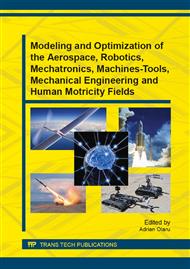p.452
p.458
p.466
p.479
p.485
p.491
p.497
p.505
p.511
Conceptual Approach of the Environmental Impact Issued by the Manufacturing Process
Abstract:
A product manufacturing involves, automatically, an amount of carbon emitted in the atmosphere. This carbon amount is determined by the consumption level of the resources in the manufacturing process, namely the consumed material and energy. The researches concerning the environmental impact issued by the manufacturing process are based on several concepts like carbon footprint and specific energy consumption, in order to reveal solutions for diminishing this impact. Here, we are introducing a deeper approach of the same issue, grounded on a broader meaning of the environmental impact concept. We are also suggesting a dedicated indicator to measure this impact: the ecological earning power (EcoEP), which is defined by making a connection between the earning power and the environmental impact, judged at the same level (be it the process / operation / job / order / manufacturing system level). EcoEP represents, in fact, a trade off between the economical target of the manufacturer (to earn) and the consequence of its actions, regarded from ecological point of view.
Info:
Periodical:
Pages:
485-490
Citation:
Online since:
June 2014
Authors:
Price:
Сopyright:
© 2014 Trans Tech Publications Ltd. All Rights Reserved
Share:
Citation:


